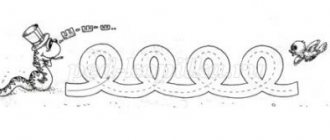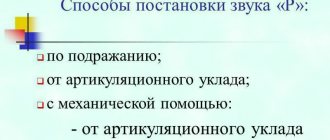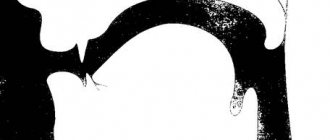Article:
The sound r is a consonant, hard, trembling.
The sound ry is a consonant, soft, trembling.
The correct aticulation of the sound p is as follows:
- lips - half-opened or occupy the position necessary to pronounce the subsequent sound (usually a vowel);
- teeth - open;
- tongue - the wide tip of the tongue is raised upward to the tubercles behind the teeth (alveoli), tense, the back of the tongue is raised, air passes freely between it and the palate, the lateral edges of the tongue fit tightly to the upper molars;
- vocal cords - vibrate, giving voice;
- the air stream is very powerful; when exhaling, it passes through the oral cavity, hits the tense tip of the tongue and vibrates it.
The soft sound r differs in articulation from the paired hard sound p by the additional rise of the middle part of the back of the tongue towards the palate and some movement forward.
Sound production.
The child pronounces the sound z with the articulation indicated above, which resembles the sound r , but without vibration of the tip of the tongue. If instead of r you hear the sound z, you need to ask the child to move his tongue closer to his teeth. Slightly intensifying the air stream by adding the sound a, we hear the syllable ra. With other vowels the sound combinations ry, ro, ru are obtained. This preparation gradually and firmly establishes correct articulation in the child, but without vibration of the tip of the tongue. The resulting sound p is called proto
Characteristics of the sounds L, L and the correct position of the speech organs when pronouncing them.
The sound l is a consonant, voiced, hard.
The sound l is consonant, sonorous, soft.
During the correct pronunciation of the sound l, the speech organs take the following position:
- the lips are open, occupy a neutral position or take the position of the subsequent vowel sound;
- the teeth are slightly open;
- tongue - the narrow tip of the tongue rises and rests on the upper incisors or their gums, the middle part of the tongue is lowered, the lateral edges are also lowered;
- a gap remains between the lateral edges of the tongue and the molars, through which an air stream emerges.
- The vocal cords are tense and vibrate to produce the voice.
The soft sound l differs from the hard sound as follows:
- lips stretched to the sides, as if smiling;
- tongue - the tip of the tongue is raised slightly higher and rests on the alveoli (“tubercles”) behind the front upper teeth, the middle and back parts of the tongue are raised and moved forward, which gives softening.
Characteristics of hissing sounds and their articulation.
The group of hissing sounds includes the sounds sh, zh, ch, shch .
Sound Sh.
The sound sh is consonant, dull, hard. There is no corresponding soft sound in the Russian language.
When pronouncing the sound w, the speech organs normally take the following position:
- the lips are slightly pushed forward;
- the tip of the tongue is raised to the palate (to the alveoli), but does not touch it, forming a gap;
- the lateral edges of the tongue are pressed from the inside to the upper molars or hard palate, without allowing a stream of exhaled air to pass along the sides. Thus, the tongue takes the shape of a ladle or cup.
- the vocal cords are open, the stream of exhaled air passes freely between them;
- the air stream is exhaled evenly in the middle of the tongue, it is strong, wide, warm, and can be easily felt with the back of the hand raised to the mouth.
Any deviation from the correct articulation pattern leads to sound distortion. When producing a sound, our main task is to create in the child the correct articulation of this sound.
The articulation of the sound w differs from the articulation of the sound w by the presence of a voice.
The articulation of the sounds sh and ch differs from the articulation of the sound sh by the additional rise of the middle part of the tongue towards the palate. In addition, the sound h is a closure-fissure, i.e., when it is articulated, the front part of the back of the tongue first closes with the alveoli, and then a gap is formed between them.
Thus, for the hissing sounds sh, zh, shch, ch, the main articulation of the sound sh , and this means that it will be basic for this group. That is, work on correcting hissing sounds must begin with the sound w . If the sound w is pronounced correctly, then by adding a voice we get the sound w ; by adding the rise of the middle part of the tongue, we get w ; adding the rise of the middle part of the tongue and the bow in front of the gap, we get h . Therefore, violations of the sounds zh, shch, ch are the same as those of w .
Sound production.
After the child learns to spread his tongue and bend it upward, the adult suggests to him: “Open your mouth slightly, lift your wide tongue over your upper teeth, like me. Now blow on your tongue. Do you hear how the wind rustled? (Air, passing through a small gap between the front edge of the tongue and the palate, forms a pinch, a pinching sound).
It happens that a child blows with the sound x , then the stream dissipates, the sound turns out fuzzy and distorted. In this case, he should be told: “Blow on the tip of your tongue, as if pronouncing the sound s , but keep your tongue up.”
Developing the correct sound sh requires repeated repetition and the use of various images (the wind makes noise, a snake hisses, air comes out of a burst balloon, etc.). The game form, combined with explanation, quickly focuses the child’s attention. Gradually, under the control of an adult, he begins to perform the required movements (round his lips and slightly move them forward) and correctly pronounce the sound sh .
It must be remembered that when introducing a sound, you should never call it to a child, so as not to cause him to habitually mispronounce it.
How is the sound Zh pronounced normally?
The group of hissing sounds includes the sounds sh, zh, ch, shch .
The sound is consonant, sonorous, hard. There is no corresponding soft sound in the Russian language.
When pronouncing the sound w, the speech organs normally take the following position:
- the lips are slightly pushed forward;
- the tip of the tongue is raised to the palate (to the alveoli), but does not touch it, forming a gap;
- the lateral edges of the tongue are pressed from the inside to the upper molars or hard palate, without allowing a stream of exhaled air to pass along the sides. Thus, the tongue takes the shape of a ladle or cup.
- the vocal cords are closed and vibrate under the pressure of the exhaled air stream;
- the air stream is exhaled evenly in the middle of the tongue, it is strong, wide, warm, and can be easily felt with the back of the hand raised to the mouth.
Any deviation from the correct articulation pattern leads to sound distortion. When producing a sound, our main task is to create in the child the correct articulation of this sound.
Sound setting [F].
After automating the sound sh in words, you can put the sound zh . Give your child the opportunity to feel the vibration of the vocal cords when pronouncing the sound z . Place the back of your baby's hand on the front of your neck. sh with your child and add your voice. With one hand the child should feel the vibration of your vocal cords, with the other - with himself.
An isolated sound is reinforced using onomatopoeia (imitation of the buzzing of a beetle, bee, bumblebee, rotation of a spinning top, etc.)
After the child learns to pronounce an isolated sound correctly, you can begin to automate it and introduce it into normal speech.
How to pronounce the sound Ch normally.
The sound Ch is consonant, dull, soft. There are no paired voiced and hard sounds in the Russian language.
At the moment of pronouncing the sound Ch, the organs of articulation occupy the following position:
- lips slightly pushed forward and rounded;
- the teeth are brought together, only a narrow gap remains between them;
- the wide tip of the tongue is raised to the front of the hard palate; the middle part of the back of the tongue is lowered, forming a depression; the lateral edges of the tongue are pressed against the upper molars;
- an air stream passes with force through a narrow gap between the alveoli and the front part of the tongue (at the beginning of articulation, the tip of the tongue closes with the base of the upper incisors, and then sharply moves back), the exhalation is stronger than when pronouncing the sound w, more intense, the air is exhaled with a push and passes in the middle of the tongue;
- the soft palate is raised, pressed against the back wall of the pharynx and closes the passage into the oral cavity;
- the vocal cords are not tense, they are spread apart, the voice is not formed.
- Sound production Ch.
- The sound Ch can be made in two ways.
- Method 1. t-t-t at a fast pace (the tip of the tongue touches the base of the upper incisors). Then we gradually begin to move the tip of the tongue back, as if stroking the upper alveoli. At the same time, we stretch our lips wide in a smile. The result should be a clear Ch sound.
- Method 2. First slowly, then increasing the pace, we pronounce a combination of sounds th and sh - dark . Don't forget to smile widely. It is important!
- Practice pronouncing the sound Ch in isolation for some time: “How does the clock tick?” - “Ch-ch-ch.” “How does a grasshopper chirp?” - “Ch-ch-ch.” “How to calm a noisy baby?” - “Ch-ch-ch.”
How to pronounce the sound [s] normally.
The sound [s] is a consonant, dull, hard. Paired with it in terms of hardness and softness is the sound [c'] (“s”). Paired in terms of voicedness and deafness is the sound [z].
When pronouncing the sound [s], the organs of articulation occupy the following position:
- - the lips are slightly stretched in a smile, so that the upper and lower incisors are exposed;
- - the teeth are brought together, forming a gap of 1-2 mm;
- - the tip of the tongue is wide, located in the lower part of the lower front teeth;
- - the lateral edges of the tongue are raised and tightly meet the upper lateral teeth;
- - the back of the tongue in its front part forms a narrow gap with the upper alveoli for the exit of a stream of air;
- - the air stream is strong, passes through the middle of the tongue and when you bring the back of your hand to your mouth it feels cold;
- - the soft palate is pressed tightly against the back wall of the pharynx, preventing air from escaping into the nose;
- - vocal cords are open and do not form a voice.
Attention! Any deviation from this articulation, which does not lead to distortion of the sound by ear, is considered a variant of the norm.
Sound setting [s].
Method 1. “Let's remember the exercise “Kick the ball into the goal.” Smile wide, show your teeth and say the sound [i] to yourself. Now, with such a beautiful smile, blow on the ball.” When performing this exercise, it is important to ensure that the lips do not come close, do not cover the teeth, and that the tip of the tongue is strictly behind the lower teeth. The result is a weak but clear [c] sound. The pronunciation of sound is fixed in onomatopoeia.
Method 2. If the first method did not work, you can use mechanical help. We make a wide smile, teeth are exposed, the tip of the tongue is behind the lower teeth. On the tip of the tongue we place a thin wooden stick in the middle, for example, a match without a sulfur head. We press lightly with a stick, thus forming a groove for an air stream along the middle line of the tongue. The child blows on the tip of his tongue. The sound [s] is heard. Attention! The air stream should be strong, narrow and feel cold (not warm!) when you bring the back of your hand to your mouth.
Mechanical assistance can be used at the stage of pronunciation of isolated sounds (onomatopoeia) and syllables. Then we gradually remove the stick. When the child learns to pronounce the correct sound [c] independently, without mechanical assistance, you can move on to automating this sound in words and sentences.
How to pronounce the sound [z] normally.
The sound [z] is a consonant, voiced, hard. Paired with it in softness is the sound [z'] (“z”), Paired in deafness is the sound [s].
When pronouncing the sound [z], the organs of articulation occupy the following position:
- - the lips are slightly stretched in a smile, so that the upper and lower incisors are exposed;
- - the teeth are brought together, forming a gap of 1-2 mm;
- - the tip of the tongue is wide, located in the lower part of the lower front teeth;
- - the lateral edges of the tongue are raised and tightly meet the upper lateral teeth;
- - the back of the tongue in its front part forms a narrow gap with the upper alveoli for the exit of a stream of air;
- - the air stream is strong, passes through the middle of the tongue and when you bring the back of your hand to your mouth it feels cold;
- - the soft palate is pressed tightly against the back wall of the pharynx, preventing air from escaping into the nose;
- - the vocal cords are closed and tremble, forming the voice.
Attention! Any deviation from this articulation, which does not lead to distortion of the sound by ear, is considered a variant of the norm.
How to pronounce the soft sound [z'] normally.
The sound [з'] ("зь") is a consonant, sonorous, soft. Its counterpart in hardness is the sound [z]. Paired in deafness is the sound [s'] (“s”).
When pronouncing the sound [з'], the organs of articulation occupy the following position:
- - the lips are slightly stretched in a smile, so that the upper and lower incisors are exposed;
- - the teeth are brought together, forming a gap of 1-2 mm;
- - the tip of the tongue is wide, located in the lower part of the lower front teeth;
- - the lateral edges of the tongue are raised and tightly meet the upper lateral teeth;
- - the back of the tongue in its middle part forms a narrow gap with the upper alveoli for the exit of a stream of air;
- - the air stream is strong, passes through the middle of the tongue and when you bring the back of your hand to your mouth it feels cold;
- - the soft palate is pressed tightly against the back wall of the pharynx, preventing air from escaping into the nose;
- - the vocal cords are closed and tremble, forming the voice.
Attention! Any deviation from this articulation, which does not lead to distortion of the sound by ear, is considered a variant of the norm.
Sound setting [z].
The sound [z] is easily differentiated from the sound [c], since these sounds have the same articulatory structure, that is, when pronouncing these sounds, the organs of articulation occupy the same position. The difference between the sounds is that [s] is voiceless, pronounced without a voice, and [z] is voiced, pronounced with a voice. Thus, to cause the sound [z], it is enough to add, “turn on” the voice when pronouncing the sound s.
The presence or absence of voice can be controlled by ear, as well as by tactile-vibration control. To do this, apply the back of the hand to the front surface of the neck in the larynx area. When you “turn on” your voice, your hand feels a slight vibration transmitted from the vocal folds. When you turn off the voice, the vibration disappears.
You can explain to children that when the little voice in the neck is “sleeping,” we don’t feel it, but when it wakes up, we can feel it jumping and having fun in its little house—the neck.
Having received the correct sound [z], you should practice pronouncing it for some time in isolation from other sounds: z-z-z. Children can be asked to ring like a mosquito or a bell.
After this, you can move on to sound automation, first in syllables, then in words, sentences and connected texts.
How to pronounce the sound Ts normally.
The sound Ts (in Russian transcription [ts]) is a consonant, deaf, hard. It is formed by merging the sounds [t] and [s] into a single sound. There are no sounds equivalent to it in terms of sonority and softness in the Russian language.
When pronouncing the sound [ts], the organs of articulation occupy the following position:
- - the lips are slightly stretched in a smile, so that the upper and lower incisors are exposed;
- - the teeth are brought together, forming a gap of 1-2 mm;
- - the tip of the tongue is wide, located in the lower part of the lower front teeth;
- - the lateral edges of the tongue are raised and tightly meet the upper lateral teeth;
- - the back of the tongue in its front part closes tightly with the upper alveoli for a split second, as when pronouncing [t], after which it forms a narrow gap with them (v. alveoli) for the exit of a stream of air, as when pronouncing [s];
- - the air stream is strong, jerky, passes through the middle of the tongue and when you bring the back of your hand to your mouth it feels cold;
- - the soft palate is pressed tightly against the back wall of the pharynx, preventing air from escaping into the nose;
- - vocal cords are open and do not form a voice.
Attention! Any deviation from this articulation, which does not lead to distortion of the sound by ear, is considered a variant of the norm.
How to pronounce the sound [k] normally.
The sound [k] is a consonant, dull, hard. Paired with it in terms of hardness and softness is the sound [k'] (“k”). Paired in terms of voicedness and deafness is the sound [g].
When pronouncing the sound [k], the organs of articulation occupy the following position:
- lips parted, stretched in a slight smile;
- teeth are open:
- the tip of the tongue lies at the base of the lower incisors,
- the front and middle parts of the back of the tongue are lowered,
- the back of the back of the tongue rises up and rests on the palate at the back,
- the lateral edges of the tongue are pressed against the upper lateral teeth;
- the soft palate is raised, pressed against the back wall of the pharynx and closes the passage into the nasal cavity;
- vocal cords are not tense, open - the voice is not formed;
- the air stream is strong, at the moment of pronouncing the sound it passes through the center of the oral cavity, breaking the bridge between the back of the back of the tongue and the palate.
Attention! Any deviation from this articulation, which does not lead to distortion of the sound by ear, is considered a variant of the norm.
Sound setting [k]
Ref. position: lips are parted, stretched in a slight smile, teeth are open, the tip of the tongue lies at the base of the lower incisors.
We pronounce the syllables TA-TA-TA...
While pronouncing the syllables, use a cleanly washed finger or the tip of a cotton swab to lightly press on the front of the back. tongue, gradually moving it back into the depths of the mouth. As the tongue moves away, we hear: TA-TA-TA-TA-TA-TA-KYA-KYA-KYA-KA-KA-KA.
We gradually weaken the mechanical assistance, reducing it to “nothing.” Now the tongue can hold the correct position on its own.
Sound setting [z]
Creates an imaginary situation:—
I didn’t want to come to your lesson alone, we went to class with a hare. But unfortunately, he couldn’t pass, he needed to leave urgently, but he gave me an envelope, although I don’t know what’s in it. Let's watch?
(opens the envelope and takes out emoticons).
- Guys, look what friends the hare sent us (takes out emoticons from the envelope).
- So that they don’t get bored, let’s play with them a little. Let's show the same emotions that emoticons depict.
- What exercises did we do now?
- Why did we do these exercises?
- I think our emoticons are tired and we will give them a rest.
The next exercise we will do is a breathing exercise. Let's learn to breathe correctly.
We take the pinwheels in our hands, inhale through the nose and exhale through the mouth. We direct the air stream at the turntable so that it begins to spin.
— We breathe correctly: we don’t puff out our cheeks, we don’t raise our shoulders, we inhale through the nose, exhale through the mouth.
- What were we doing with you now?
- Why did we do it?
Our emoticons have rested and now they want to go for a walk in the forest and invites us to join them.
— We are walking along a forest path. A light breeze is blowing, the trees in the forest stand calmly (shows a picture of a tree).
The wind blows quietly, like this: “
oo-oo-oo
”
[ u] quietly and for a long time ).
- Let's show together how a light breeze blows.
- Here we come to a forest clearing. And suddenly a strong wind blew, the trees began to sway (shows a picture of a tree bending from the wind
).
The wind hummed loudly: “ oo-oo-oo
...”
(pronounces this sound loudly and for a long time).
- Let's show together how a strong wind blows.
- And now I will show you pictures. When I show 1 picture, you will depict a light breeze, and when 2, you will depict a strong wind.
- What were we doing now?
— What did you learn by doing this exercise?
“You and I had a nice walk in the forest and now we’re going home.”
When I went to class, I really wanted to show you the unusual beads that I made with my own hands, but unfortunately, they fell apart. Please help me collect them. (self-massage)
- What were we doing now?
- Why did you do it?
— Our emotions are somehow bored. They invite us to do articulatory gymnastics:
- "Smile-pipe."
- “Let’s paint the lower fence.”
- "Pancake."
- "Needle"
- "Delicious jam"
What were we doing now?
- That's right, you're great. Emotions really liked the way you performed articulatory gymnastics.




